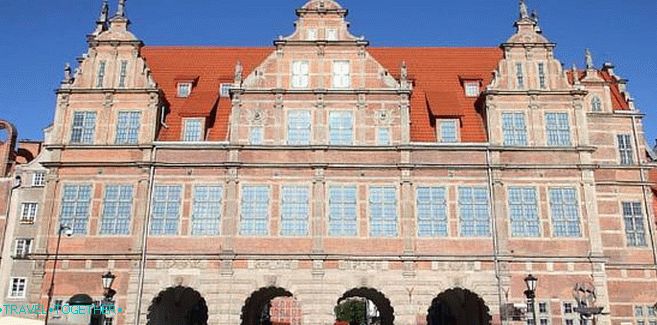Gdansk, Poland – detailed information about the city. Guide to Gdansk: popular attractions with photos and descriptions.
Contents
City Gdansk (Poland)
Gdansk – a city in the north of Poland with remarkable architecture, a major seaport on the Baltic Sea. The city is the sixth population in the country. Gdansk is the sea capital of Poland. This city with a glorious thousand-year history that has always played a key role in the region, as one of the main places of trade. Such a city as Gdansk is one of a kind in Poland. Unique the location and the spirit of freedom, which is an age-old tradition, created here is its special atmosphere, which is not possible to penetrate fall in love with this city.
- Story
- sights
- Climate
- Accommodation
- Kitchen and food
- Interesting museums
- Gdańsk Guide (map)
Story
Let us turn to a brief excursion into the history of Gdansk … The history of the city starts in 997 By this time, the first written references to Gdansk.
In the 12th century the Germans began to settle here. And at the beginning of the 14th century the city was captured by the knights of the Teutonic Order and attached to Prussia. The city was renamed to German manners – Danzig.
In 1466, after the end of the Thirteen Years War, Gdansk returned to Poland. Then the city received wide privileges: here they independently elected mayors, led independent foreign policy, had their own coin. In 1793, after the partition of Poland, the city again became part of Prussia.
 Night Gdansk
Night Gdansk
After the First World War, Danzig received the status of a free city under the direction of the League of Nations. But at the same time Poland used the port cities. He also entered the customs zone of Poland.
In September 1939, Gdansk as a result of the German attack became part of East Prussia. Gdansk was liberated by the Soviet troops in March 1945. When liberating the city was strong ruined.
After the war, the restoration of the city’s architecture began. Process restoration is still ongoing, although the old city has been restored almost completely.
Modern Gdańsk is the capital of the Pomeranian Voivodeship and is one of the main centers of economic and administrative life in Poland. Gdansk is a major maritime and industrial center. Developed petrochemical industry, shipbuilding and ship repair. High-tech areas are also developing: electronics, telecommunications. An important part of the local economy is amber treatment. Gdansk has an international airport.
Public transport of the city is represented by buses and trams.
Climate
The climate is wet sea, with mild winters and rainy summers. The average air temperature ranges from −1.0 ° C to + 17.2 ° C. Seasons are clearly distinguishable. In early spring usually cold and windy and then the weather becomes warm and pretty sunny.
Accommodation
In Gdansk, as in any tourist center, there is a large number of hotels and apartments for every taste and budget. The only caveat – it is desirable to book accommodation in advance.
Kitchen and food
Gdansk offers a variety of catering establishments A variety of cuisines – European, Asian and Middle Eastern. AT city a huge selection of places where you can eat, drink coffee (tea) or something stronger. Also in Gdansk you can try original regional dishes. We recommend the following Regional restaurants:
- PALOWA, ul. Długa 47, 80-831 Gdańsk
- TAWERNA DOMINIKAŃSKA, ul. Targ Rybny 9, 80-838 Gdańsk
Also in April in Gdansk in restaurants held promotions which some dishes have a 50% discount.
Interesting museums of Gdansk
For fans of museums we publish interesting museum of Gdansk.
Historical Museum -ul. Długa 47, 80-831 Gdańsk
Exposure:
- City Hall.
- Arthur’s Court
- Tower Clock Museum
- Museum of the Polish Post
- Fortress
- Amber Museum
National Museum -ul. Toruńska1 80-822 Gdańsk
Exposure:
- Department of Antique Art
- Modern Art Abbey Palace
- Department of Ethnography – Granaries
- Photography gallery
- Nobility museum
National Museum -ul. Toruńska1 80-822 Gdańsk
Exposure:
- Department of Antique Art
- Modern Art Abbey Palace
- Department of Ethnography – Granaries
- Photography gallery
- Nobility museum
National Maritime Museum – Ołowianka 9 – 13 80-751 Gdańsk
Exposure:
- Granaries on Olovyanka
- Ship – Museum “Sołdek”
- Marine Culture Center
- Ship – Museum “Dar Pomorie”
- Fisheries Museum
- Museum of the Vistula River
Boat ride
To see Gdansk from a different angle you can rent the boat.
Sights of Gdansk
The main attraction of Gdansk is the Old Town, which is an architectural complex of 13-18 centuries. Also interesting sights of Gdansk are: courtyard Arthur, Green and Golden Gate, Abat Palace, Town Hall, beautiful ancient churches and royal road.
 Royal tract
Royal tract
The Royal Route is the old road of Gdansk. This is the front entrance to the city that starts at the city gate complex and ends at the Long Market Square.
Limit the path of the Golden and Green Gate.
 Green gate
Green gate
Green Gate (Polish. Brama Zielona) – the oldest river the gates that have been known since 1357. Together with others gates (Gold and High) limit the Royal Route. Built in the years 1564-1568. Hans Kremer of Dresden and Rainier Amsterdam. Four passes are made in the facade of the building. Green the gate is very similar to the castle. Not used for construction a small brick found in Gdansk, called Dutch. Now the Green Gate is a department of the National Museum in Gdansk. It hosts exhibitions, conferences, presentations.
 Golden Gate
Golden Gate
Golden Gate (Polish. Złota Brama) – the gate in Gdansk on the street. Dluga. One of the most famous landmarks of the city. Were built at the beginning of the 17th century on the site of the old gothic gate 13 century. The gates were built by Jan Strakowski according to the architect’s design. Abraham van den Block. The style of architecture is Dutch Mannerism. The Golden Gate was destroyed in World War II. Restored in 1957.
 Town hall
Town hall
Town Hall (Polish. Ratusz Głównego Miasta) – Town Hall Square The long market of Gdansk. Town Hall Tower was built at the end of 15 century. After the fire of 1556, the Gothic Town Hall was rebuilt. Town Hall Tower received a new spire, decorated with a statue of the king Sigismund II Augusta. From the tower, which is 81 meters high, it opens excellent panorama of the city. The interior of the town hall was created at the turn of XVI. – XVII centuries and already at that time was one of the most beautiful in its kind of After World War II the town hall was restored in 1970 year At the moment, the town hall is a museum.
 Neptune Fountain
Neptune Fountain
The Neptune fountain is installed on the square of the long market. Sculpture for the fountain was made of bronze in about 1615. Fountain was officially opened in 1634. Was damaged during the second world war. Restored in 1954.
 Arthur’s Court
Arthur’s Court
Arthur’s Yard is another highlight of the Long Market. Initially, the building was intended for trade meetings. Title The palace received thanks to the legend of King Arthur. Heyday courtyards fall on the 17-18 century. Although his story begins much earlier. Already in the middle of the 14th century in its place stood an old building which suffered during the fire. Unfortunately the building was very badly damaged in 1945.
 Church of sv. Yana
Church of sv. Yana
Church of sv. Jana (Polish. Kościół w. Jana) – Gothic Church in the historic center of Gdansk. This is one of the most significant monuments of the city.
The first mention of the church dates from the 14th century. In place of the church there was a small chapel. The new church was built in early 15th century. The church was badly damaged in 1945. The restoration of the temple took dozens of years.
The length of the church is 55 meters, width 20. The tower has a height 47 meters. The tower is crowned with a thin bell tower.

Basilica of the Assumption of the Blessed Virgin Mary (Polish. Bazylika konkatedralna Wniebowzięcia Najświętszej Marii Panny w Gdańsku) – Gothic cathedral, which locals consider the largest brick church in the world. The church was built in the 13-14 century in strict gothic style. Until 1945 – the largest Lutheran church. AT 1945 the church was significantly damaged. In 1955 the church restored.
 Abbatial palace
Abbatial palace
Abbey Palace in Oliwa – a rococo palace built in 1754 – 1756 In 1945 the building burned down. It was restored in the 60s of the 20th century. Since 1989 here is located Department of Contemporary Art of the National Museum of Gdansk. Address – Cystersów 18, 80-001 Gdańsk






